Impact of Self-Determination Policies on Aboriginal Australians: Essay
VerifiedAdded on 2023/06/04
|10
|2672
|490
Essay
AI Summary
This essay critically evaluates the effectiveness of self-determination policies implemented in Australia for Aboriginal communities since the 1970s. It examines the context of the United Nations Covenant on Civil and Political Rights and its relevance to Aboriginal rights. The essay explores arguments that these policies have not delivered improved outcomes, citing issues like poverty, alienation, and health disparities. It discusses the perspectives of various theorists, including Marcia Langton, and analyzes the Aboriginal and Torres Strait Islander Commission Act. The essay also considers the importance of self-determination for individual and collective capabilities, the challenges in implementation, and the impact on health, education, and social well-being. It concludes by emphasizing the need for genuine self-determination and the importance of addressing the historical disadvantages faced by Aboriginal communities, while acknowledging some progress made through specific programs. The essay highlights the ongoing debate surrounding these policies and their real-world consequences.
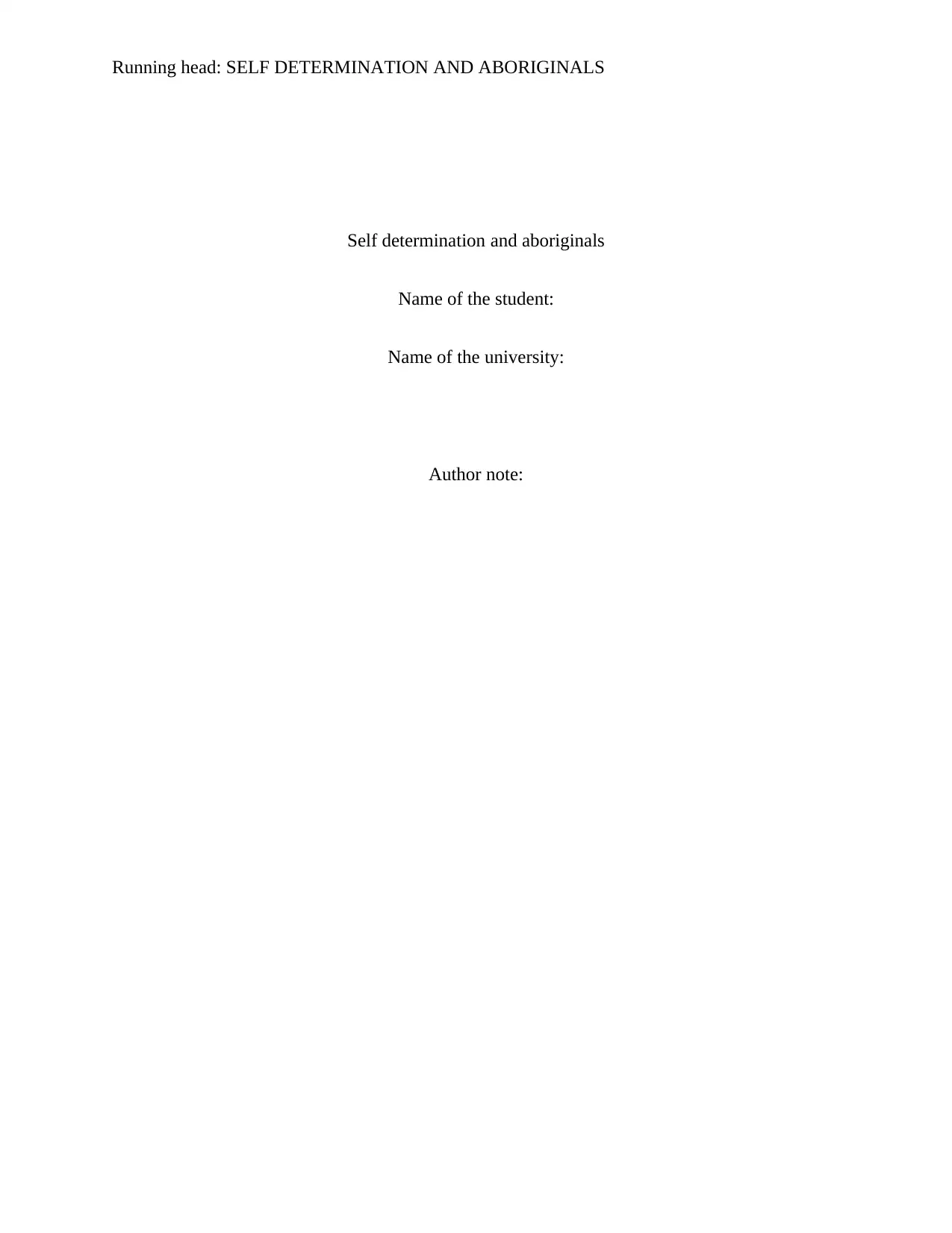
Running head: SELF DETERMINATION AND ABORIGINALS
Self determination and aboriginals
Name of the student:
Name of the university:
Author note:
Self determination and aboriginals
Name of the student:
Name of the university:
Author note:
Paraphrase This Document
Need a fresh take? Get an instant paraphrase of this document with our AI Paraphraser
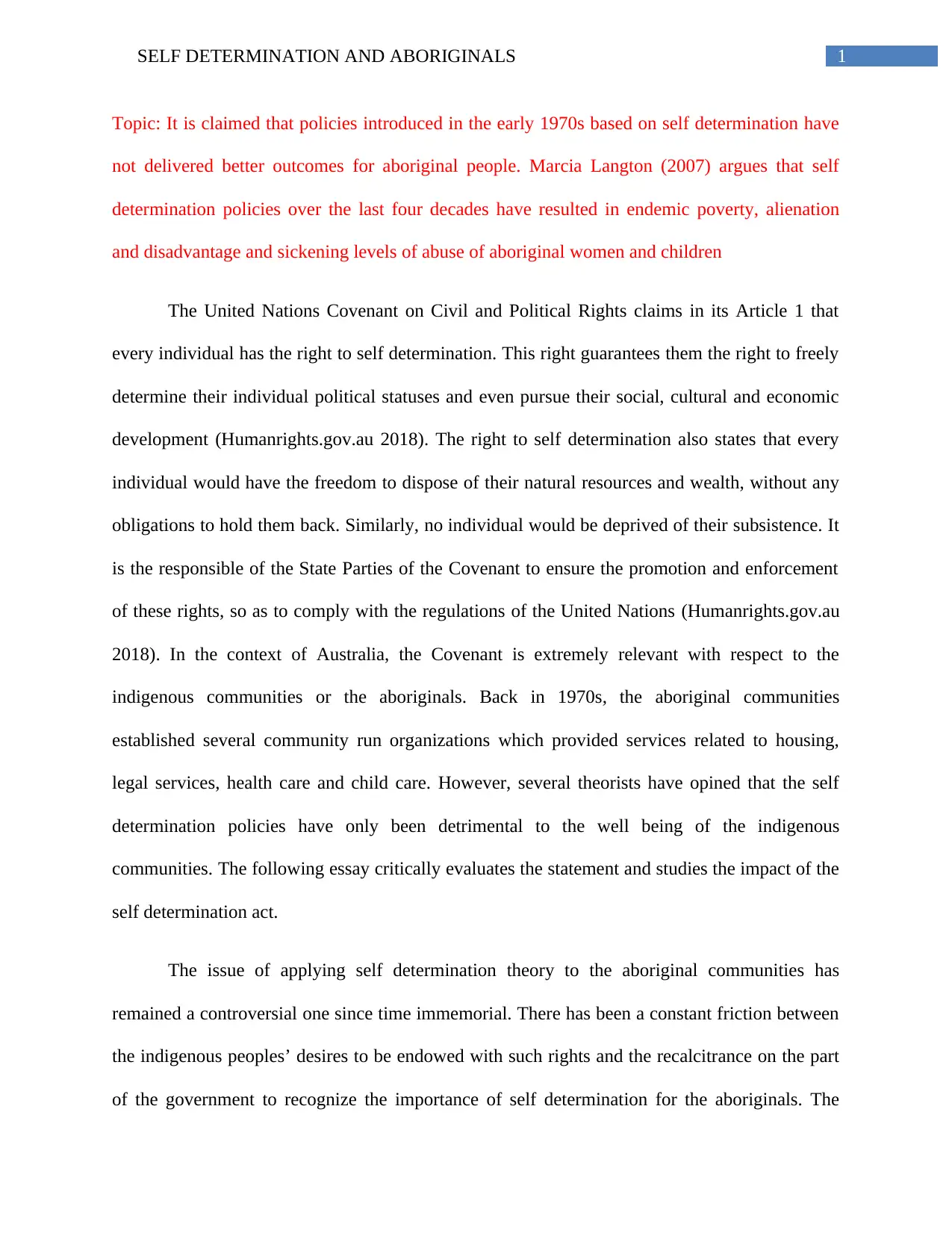
1SELF DETERMINATION AND ABORIGINALS
Topic: It is claimed that policies introduced in the early 1970s based on self determination have
not delivered better outcomes for aboriginal people. Marcia Langton (2007) argues that self
determination policies over the last four decades have resulted in endemic poverty, alienation
and disadvantage and sickening levels of abuse of aboriginal women and children
The United Nations Covenant on Civil and Political Rights claims in its Article 1 that
every individual has the right to self determination. This right guarantees them the right to freely
determine their individual political statuses and even pursue their social, cultural and economic
development (Humanrights.gov.au 2018). The right to self determination also states that every
individual would have the freedom to dispose of their natural resources and wealth, without any
obligations to hold them back. Similarly, no individual would be deprived of their subsistence. It
is the responsible of the State Parties of the Covenant to ensure the promotion and enforcement
of these rights, so as to comply with the regulations of the United Nations (Humanrights.gov.au
2018). In the context of Australia, the Covenant is extremely relevant with respect to the
indigenous communities or the aboriginals. Back in 1970s, the aboriginal communities
established several community run organizations which provided services related to housing,
legal services, health care and child care. However, several theorists have opined that the self
determination policies have only been detrimental to the well being of the indigenous
communities. The following essay critically evaluates the statement and studies the impact of the
self determination act.
The issue of applying self determination theory to the aboriginal communities has
remained a controversial one since time immemorial. There has been a constant friction between
the indigenous peoples’ desires to be endowed with such rights and the recalcitrance on the part
of the government to recognize the importance of self determination for the aboriginals. The
Topic: It is claimed that policies introduced in the early 1970s based on self determination have
not delivered better outcomes for aboriginal people. Marcia Langton (2007) argues that self
determination policies over the last four decades have resulted in endemic poverty, alienation
and disadvantage and sickening levels of abuse of aboriginal women and children
The United Nations Covenant on Civil and Political Rights claims in its Article 1 that
every individual has the right to self determination. This right guarantees them the right to freely
determine their individual political statuses and even pursue their social, cultural and economic
development (Humanrights.gov.au 2018). The right to self determination also states that every
individual would have the freedom to dispose of their natural resources and wealth, without any
obligations to hold them back. Similarly, no individual would be deprived of their subsistence. It
is the responsible of the State Parties of the Covenant to ensure the promotion and enforcement
of these rights, so as to comply with the regulations of the United Nations (Humanrights.gov.au
2018). In the context of Australia, the Covenant is extremely relevant with respect to the
indigenous communities or the aboriginals. Back in 1970s, the aboriginal communities
established several community run organizations which provided services related to housing,
legal services, health care and child care. However, several theorists have opined that the self
determination policies have only been detrimental to the well being of the indigenous
communities. The following essay critically evaluates the statement and studies the impact of the
self determination act.
The issue of applying self determination theory to the aboriginal communities has
remained a controversial one since time immemorial. There has been a constant friction between
the indigenous peoples’ desires to be endowed with such rights and the recalcitrance on the part
of the government to recognize the importance of self determination for the aboriginals. The
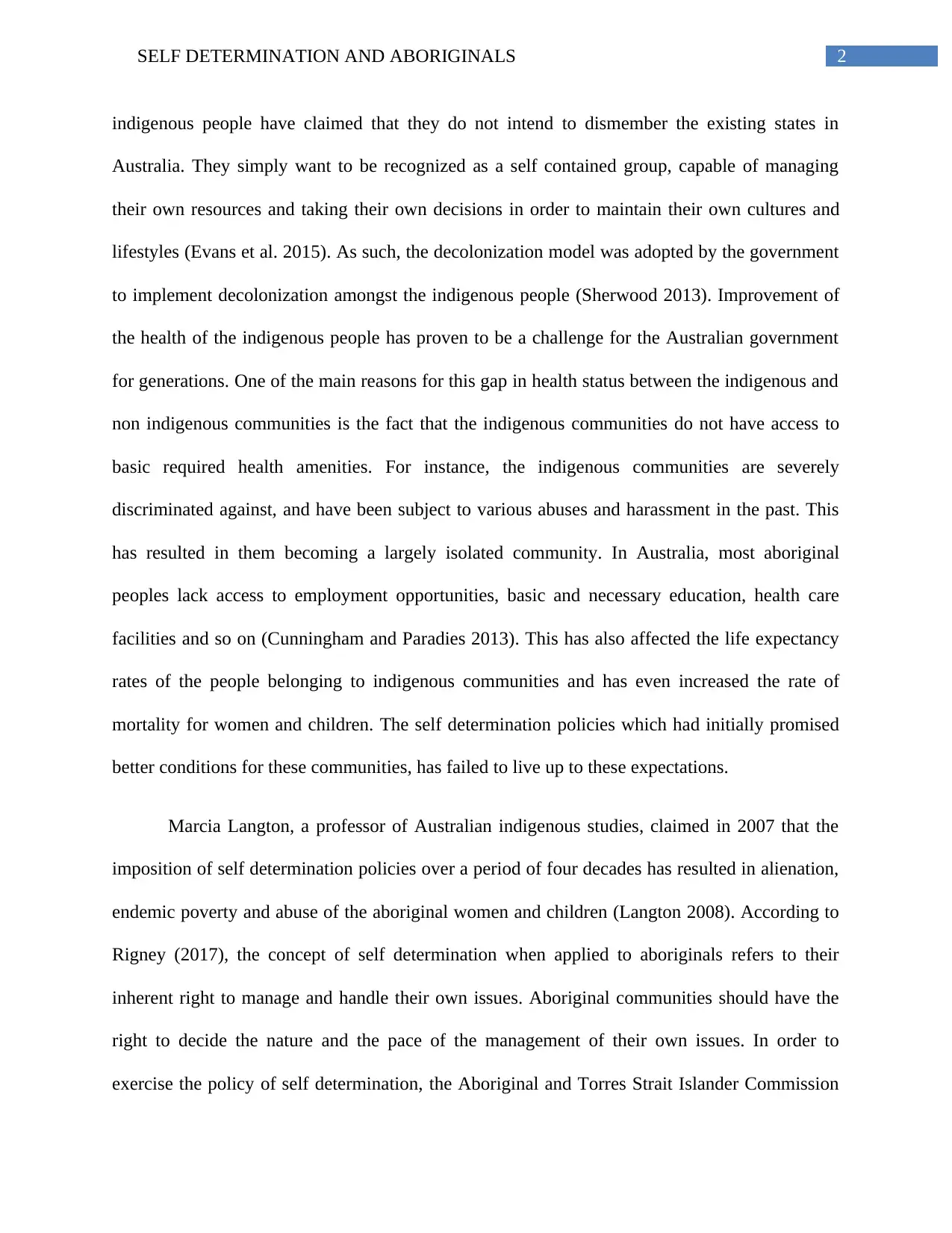
2SELF DETERMINATION AND ABORIGINALS
indigenous people have claimed that they do not intend to dismember the existing states in
Australia. They simply want to be recognized as a self contained group, capable of managing
their own resources and taking their own decisions in order to maintain their own cultures and
lifestyles (Evans et al. 2015). As such, the decolonization model was adopted by the government
to implement decolonization amongst the indigenous people (Sherwood 2013). Improvement of
the health of the indigenous people has proven to be a challenge for the Australian government
for generations. One of the main reasons for this gap in health status between the indigenous and
non indigenous communities is the fact that the indigenous communities do not have access to
basic required health amenities. For instance, the indigenous communities are severely
discriminated against, and have been subject to various abuses and harassment in the past. This
has resulted in them becoming a largely isolated community. In Australia, most aboriginal
peoples lack access to employment opportunities, basic and necessary education, health care
facilities and so on (Cunningham and Paradies 2013). This has also affected the life expectancy
rates of the people belonging to indigenous communities and has even increased the rate of
mortality for women and children. The self determination policies which had initially promised
better conditions for these communities, has failed to live up to these expectations.
Marcia Langton, a professor of Australian indigenous studies, claimed in 2007 that the
imposition of self determination policies over a period of four decades has resulted in alienation,
endemic poverty and abuse of the aboriginal women and children (Langton 2008). According to
Rigney (2017), the concept of self determination when applied to aboriginals refers to their
inherent right to manage and handle their own issues. Aboriginal communities should have the
right to decide the nature and the pace of the management of their own issues. In order to
exercise the policy of self determination, the Aboriginal and Torres Strait Islander Commission
indigenous people have claimed that they do not intend to dismember the existing states in
Australia. They simply want to be recognized as a self contained group, capable of managing
their own resources and taking their own decisions in order to maintain their own cultures and
lifestyles (Evans et al. 2015). As such, the decolonization model was adopted by the government
to implement decolonization amongst the indigenous people (Sherwood 2013). Improvement of
the health of the indigenous people has proven to be a challenge for the Australian government
for generations. One of the main reasons for this gap in health status between the indigenous and
non indigenous communities is the fact that the indigenous communities do not have access to
basic required health amenities. For instance, the indigenous communities are severely
discriminated against, and have been subject to various abuses and harassment in the past. This
has resulted in them becoming a largely isolated community. In Australia, most aboriginal
peoples lack access to employment opportunities, basic and necessary education, health care
facilities and so on (Cunningham and Paradies 2013). This has also affected the life expectancy
rates of the people belonging to indigenous communities and has even increased the rate of
mortality for women and children. The self determination policies which had initially promised
better conditions for these communities, has failed to live up to these expectations.
Marcia Langton, a professor of Australian indigenous studies, claimed in 2007 that the
imposition of self determination policies over a period of four decades has resulted in alienation,
endemic poverty and abuse of the aboriginal women and children (Langton 2008). According to
Rigney (2017), the concept of self determination when applied to aboriginals refers to their
inherent right to manage and handle their own issues. Aboriginal communities should have the
right to decide the nature and the pace of the management of their own issues. In order to
exercise the policy of self determination, the Aboriginal and Torres Strait Islander Commission
⊘ This is a preview!⊘
Do you want full access?
Subscribe today to unlock all pages.

Trusted by 1+ million students worldwide
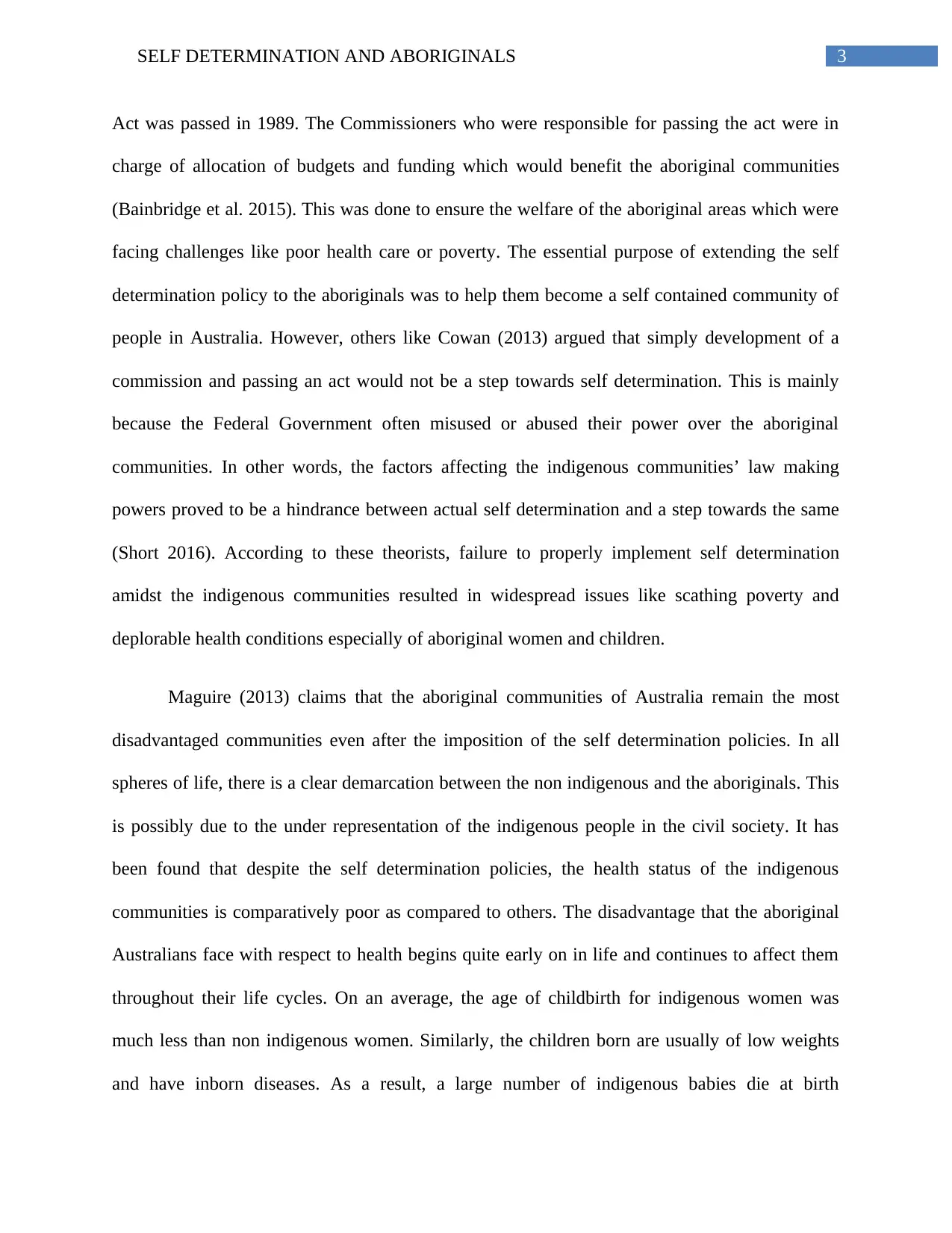
3SELF DETERMINATION AND ABORIGINALS
Act was passed in 1989. The Commissioners who were responsible for passing the act were in
charge of allocation of budgets and funding which would benefit the aboriginal communities
(Bainbridge et al. 2015). This was done to ensure the welfare of the aboriginal areas which were
facing challenges like poor health care or poverty. The essential purpose of extending the self
determination policy to the aboriginals was to help them become a self contained community of
people in Australia. However, others like Cowan (2013) argued that simply development of a
commission and passing an act would not be a step towards self determination. This is mainly
because the Federal Government often misused or abused their power over the aboriginal
communities. In other words, the factors affecting the indigenous communities’ law making
powers proved to be a hindrance between actual self determination and a step towards the same
(Short 2016). According to these theorists, failure to properly implement self determination
amidst the indigenous communities resulted in widespread issues like scathing poverty and
deplorable health conditions especially of aboriginal women and children.
Maguire (2013) claims that the aboriginal communities of Australia remain the most
disadvantaged communities even after the imposition of the self determination policies. In all
spheres of life, there is a clear demarcation between the non indigenous and the aboriginals. This
is possibly due to the under representation of the indigenous people in the civil society. It has
been found that despite the self determination policies, the health status of the indigenous
communities is comparatively poor as compared to others. The disadvantage that the aboriginal
Australians face with respect to health begins quite early on in life and continues to affect them
throughout their life cycles. On an average, the age of childbirth for indigenous women was
much less than non indigenous women. Similarly, the children born are usually of low weights
and have inborn diseases. As a result, a large number of indigenous babies die at birth
Act was passed in 1989. The Commissioners who were responsible for passing the act were in
charge of allocation of budgets and funding which would benefit the aboriginal communities
(Bainbridge et al. 2015). This was done to ensure the welfare of the aboriginal areas which were
facing challenges like poor health care or poverty. The essential purpose of extending the self
determination policy to the aboriginals was to help them become a self contained community of
people in Australia. However, others like Cowan (2013) argued that simply development of a
commission and passing an act would not be a step towards self determination. This is mainly
because the Federal Government often misused or abused their power over the aboriginal
communities. In other words, the factors affecting the indigenous communities’ law making
powers proved to be a hindrance between actual self determination and a step towards the same
(Short 2016). According to these theorists, failure to properly implement self determination
amidst the indigenous communities resulted in widespread issues like scathing poverty and
deplorable health conditions especially of aboriginal women and children.
Maguire (2013) claims that the aboriginal communities of Australia remain the most
disadvantaged communities even after the imposition of the self determination policies. In all
spheres of life, there is a clear demarcation between the non indigenous and the aboriginals. This
is possibly due to the under representation of the indigenous people in the civil society. It has
been found that despite the self determination policies, the health status of the indigenous
communities is comparatively poor as compared to others. The disadvantage that the aboriginal
Australians face with respect to health begins quite early on in life and continues to affect them
throughout their life cycles. On an average, the age of childbirth for indigenous women was
much less than non indigenous women. Similarly, the children born are usually of low weights
and have inborn diseases. As a result, a large number of indigenous babies die at birth
Paraphrase This Document
Need a fresh take? Get an instant paraphrase of this document with our AI Paraphraser
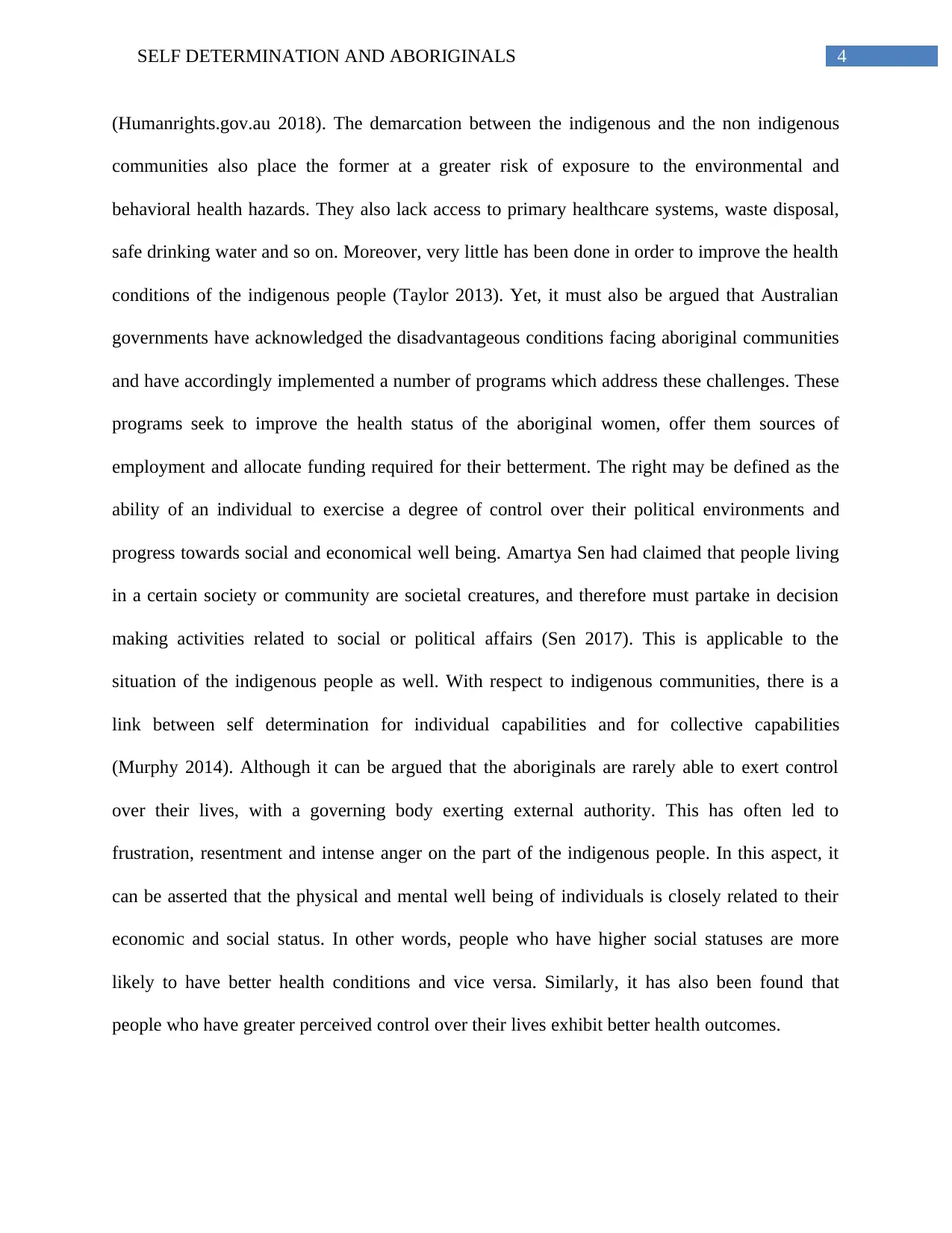
4SELF DETERMINATION AND ABORIGINALS
(Humanrights.gov.au 2018). The demarcation between the indigenous and the non indigenous
communities also place the former at a greater risk of exposure to the environmental and
behavioral health hazards. They also lack access to primary healthcare systems, waste disposal,
safe drinking water and so on. Moreover, very little has been done in order to improve the health
conditions of the indigenous people (Taylor 2013). Yet, it must also be argued that Australian
governments have acknowledged the disadvantageous conditions facing aboriginal communities
and have accordingly implemented a number of programs which address these challenges. These
programs seek to improve the health status of the aboriginal women, offer them sources of
employment and allocate funding required for their betterment. The right may be defined as the
ability of an individual to exercise a degree of control over their political environments and
progress towards social and economical well being. Amartya Sen had claimed that people living
in a certain society or community are societal creatures, and therefore must partake in decision
making activities related to social or political affairs (Sen 2017). This is applicable to the
situation of the indigenous people as well. With respect to indigenous communities, there is a
link between self determination for individual capabilities and for collective capabilities
(Murphy 2014). Although it can be argued that the aboriginals are rarely able to exert control
over their lives, with a governing body exerting external authority. This has often led to
frustration, resentment and intense anger on the part of the indigenous people. In this aspect, it
can be asserted that the physical and mental well being of individuals is closely related to their
economic and social status. In other words, people who have higher social statuses are more
likely to have better health conditions and vice versa. Similarly, it has also been found that
people who have greater perceived control over their lives exhibit better health outcomes.
(Humanrights.gov.au 2018). The demarcation between the indigenous and the non indigenous
communities also place the former at a greater risk of exposure to the environmental and
behavioral health hazards. They also lack access to primary healthcare systems, waste disposal,
safe drinking water and so on. Moreover, very little has been done in order to improve the health
conditions of the indigenous people (Taylor 2013). Yet, it must also be argued that Australian
governments have acknowledged the disadvantageous conditions facing aboriginal communities
and have accordingly implemented a number of programs which address these challenges. These
programs seek to improve the health status of the aboriginal women, offer them sources of
employment and allocate funding required for their betterment. The right may be defined as the
ability of an individual to exercise a degree of control over their political environments and
progress towards social and economical well being. Amartya Sen had claimed that people living
in a certain society or community are societal creatures, and therefore must partake in decision
making activities related to social or political affairs (Sen 2017). This is applicable to the
situation of the indigenous people as well. With respect to indigenous communities, there is a
link between self determination for individual capabilities and for collective capabilities
(Murphy 2014). Although it can be argued that the aboriginals are rarely able to exert control
over their lives, with a governing body exerting external authority. This has often led to
frustration, resentment and intense anger on the part of the indigenous people. In this aspect, it
can be asserted that the physical and mental well being of individuals is closely related to their
economic and social status. In other words, people who have higher social statuses are more
likely to have better health conditions and vice versa. Similarly, it has also been found that
people who have greater perceived control over their lives exhibit better health outcomes.
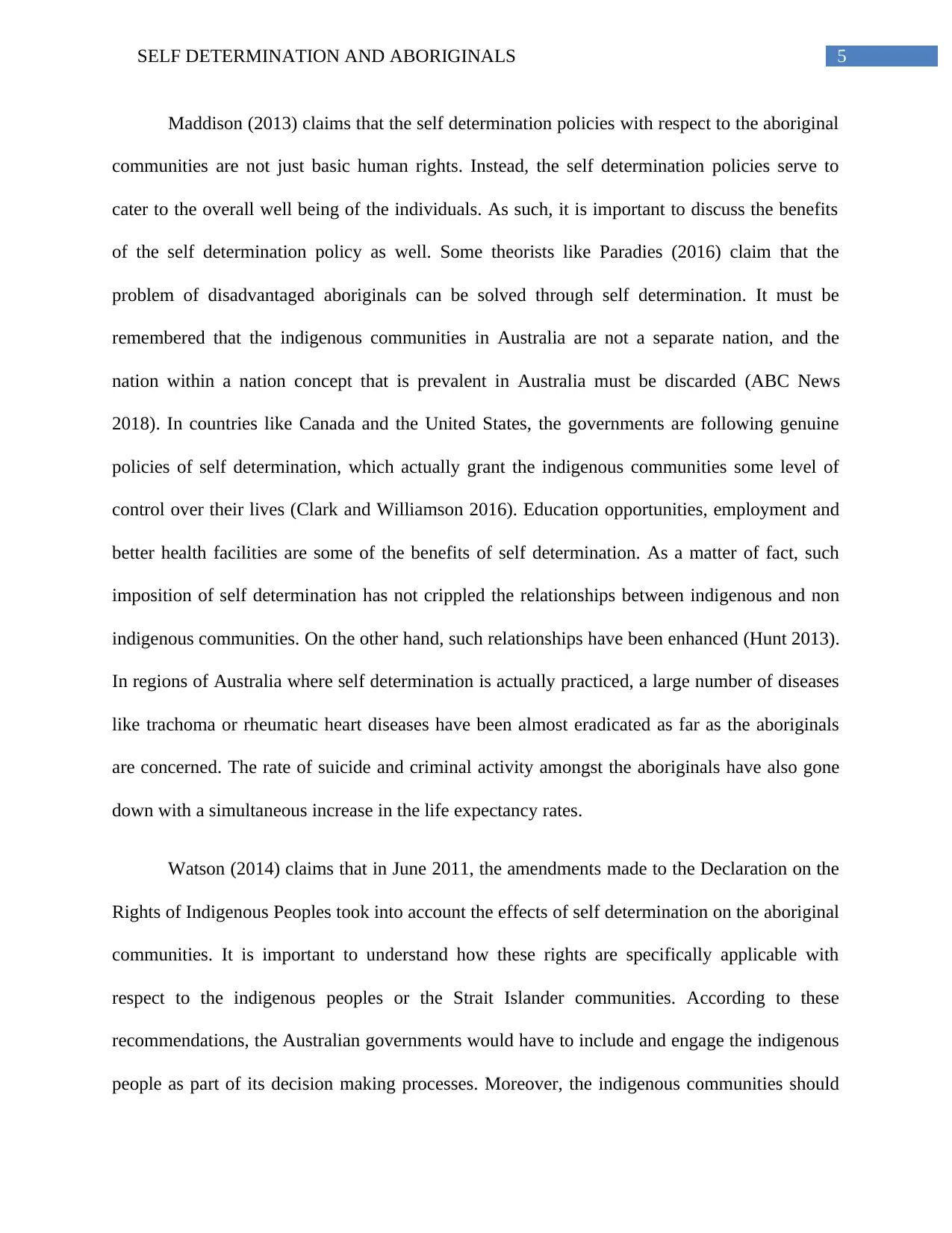
5SELF DETERMINATION AND ABORIGINALS
Maddison (2013) claims that the self determination policies with respect to the aboriginal
communities are not just basic human rights. Instead, the self determination policies serve to
cater to the overall well being of the individuals. As such, it is important to discuss the benefits
of the self determination policy as well. Some theorists like Paradies (2016) claim that the
problem of disadvantaged aboriginals can be solved through self determination. It must be
remembered that the indigenous communities in Australia are not a separate nation, and the
nation within a nation concept that is prevalent in Australia must be discarded (ABC News
2018). In countries like Canada and the United States, the governments are following genuine
policies of self determination, which actually grant the indigenous communities some level of
control over their lives (Clark and Williamson 2016). Education opportunities, employment and
better health facilities are some of the benefits of self determination. As a matter of fact, such
imposition of self determination has not crippled the relationships between indigenous and non
indigenous communities. On the other hand, such relationships have been enhanced (Hunt 2013).
In regions of Australia where self determination is actually practiced, a large number of diseases
like trachoma or rheumatic heart diseases have been almost eradicated as far as the aboriginals
are concerned. The rate of suicide and criminal activity amongst the aboriginals have also gone
down with a simultaneous increase in the life expectancy rates.
Watson (2014) claims that in June 2011, the amendments made to the Declaration on the
Rights of Indigenous Peoples took into account the effects of self determination on the aboriginal
communities. It is important to understand how these rights are specifically applicable with
respect to the indigenous peoples or the Strait Islander communities. According to these
recommendations, the Australian governments would have to include and engage the indigenous
people as part of its decision making processes. Moreover, the indigenous communities should
Maddison (2013) claims that the self determination policies with respect to the aboriginal
communities are not just basic human rights. Instead, the self determination policies serve to
cater to the overall well being of the individuals. As such, it is important to discuss the benefits
of the self determination policy as well. Some theorists like Paradies (2016) claim that the
problem of disadvantaged aboriginals can be solved through self determination. It must be
remembered that the indigenous communities in Australia are not a separate nation, and the
nation within a nation concept that is prevalent in Australia must be discarded (ABC News
2018). In countries like Canada and the United States, the governments are following genuine
policies of self determination, which actually grant the indigenous communities some level of
control over their lives (Clark and Williamson 2016). Education opportunities, employment and
better health facilities are some of the benefits of self determination. As a matter of fact, such
imposition of self determination has not crippled the relationships between indigenous and non
indigenous communities. On the other hand, such relationships have been enhanced (Hunt 2013).
In regions of Australia where self determination is actually practiced, a large number of diseases
like trachoma or rheumatic heart diseases have been almost eradicated as far as the aboriginals
are concerned. The rate of suicide and criminal activity amongst the aboriginals have also gone
down with a simultaneous increase in the life expectancy rates.
Watson (2014) claims that in June 2011, the amendments made to the Declaration on the
Rights of Indigenous Peoples took into account the effects of self determination on the aboriginal
communities. It is important to understand how these rights are specifically applicable with
respect to the indigenous peoples or the Strait Islander communities. According to these
recommendations, the Australian governments would have to include and engage the indigenous
people as part of its decision making processes. Moreover, the indigenous communities should
⊘ This is a preview!⊘
Do you want full access?
Subscribe today to unlock all pages.

Trusted by 1+ million students worldwide
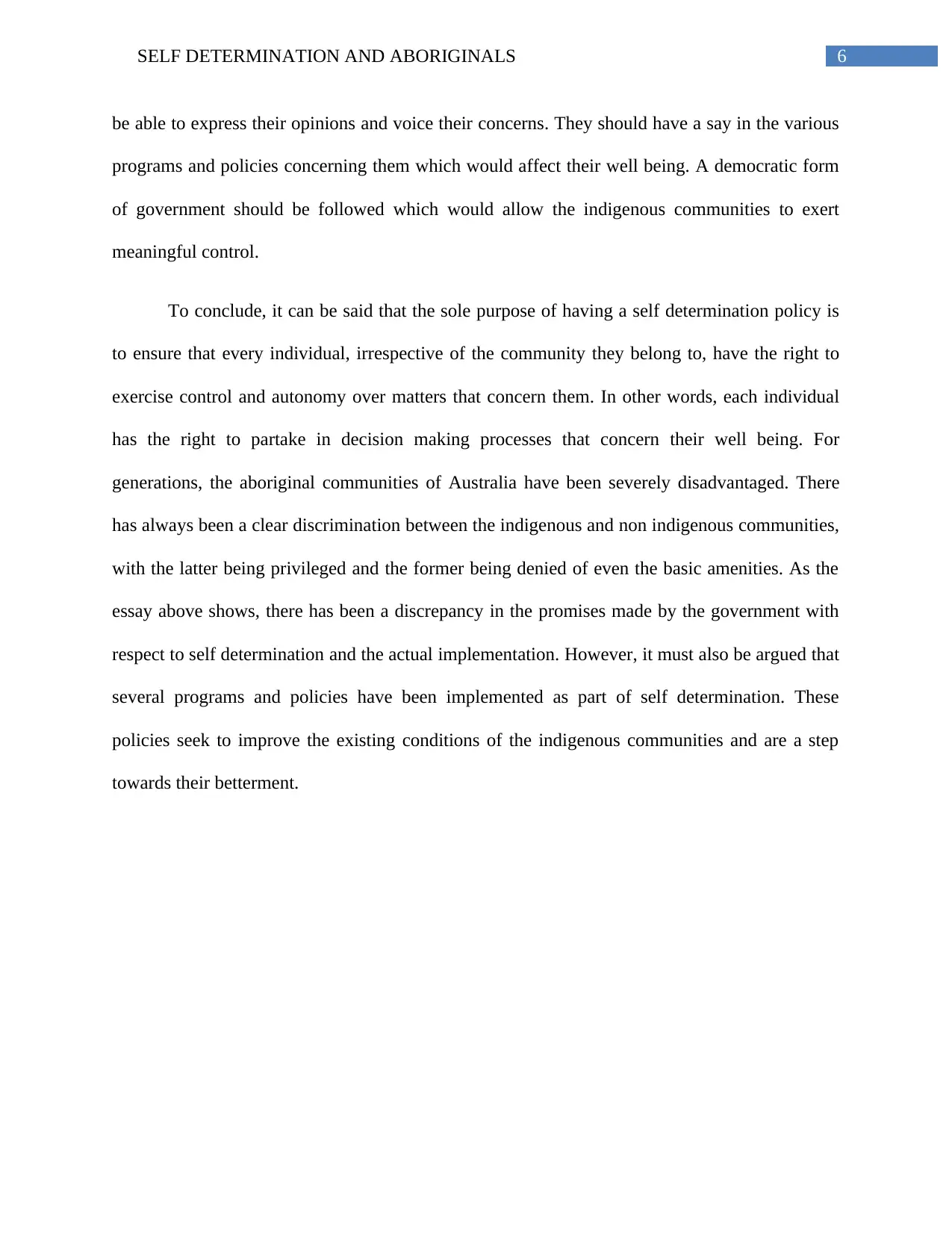
6SELF DETERMINATION AND ABORIGINALS
be able to express their opinions and voice their concerns. They should have a say in the various
programs and policies concerning them which would affect their well being. A democratic form
of government should be followed which would allow the indigenous communities to exert
meaningful control.
To conclude, it can be said that the sole purpose of having a self determination policy is
to ensure that every individual, irrespective of the community they belong to, have the right to
exercise control and autonomy over matters that concern them. In other words, each individual
has the right to partake in decision making processes that concern their well being. For
generations, the aboriginal communities of Australia have been severely disadvantaged. There
has always been a clear discrimination between the indigenous and non indigenous communities,
with the latter being privileged and the former being denied of even the basic amenities. As the
essay above shows, there has been a discrepancy in the promises made by the government with
respect to self determination and the actual implementation. However, it must also be argued that
several programs and policies have been implemented as part of self determination. These
policies seek to improve the existing conditions of the indigenous communities and are a step
towards their betterment.
be able to express their opinions and voice their concerns. They should have a say in the various
programs and policies concerning them which would affect their well being. A democratic form
of government should be followed which would allow the indigenous communities to exert
meaningful control.
To conclude, it can be said that the sole purpose of having a self determination policy is
to ensure that every individual, irrespective of the community they belong to, have the right to
exercise control and autonomy over matters that concern them. In other words, each individual
has the right to partake in decision making processes that concern their well being. For
generations, the aboriginal communities of Australia have been severely disadvantaged. There
has always been a clear discrimination between the indigenous and non indigenous communities,
with the latter being privileged and the former being denied of even the basic amenities. As the
essay above shows, there has been a discrepancy in the promises made by the government with
respect to self determination and the actual implementation. However, it must also be argued that
several programs and policies have been implemented as part of self determination. These
policies seek to improve the existing conditions of the indigenous communities and are a step
towards their betterment.
Paraphrase This Document
Need a fresh take? Get an instant paraphrase of this document with our AI Paraphraser
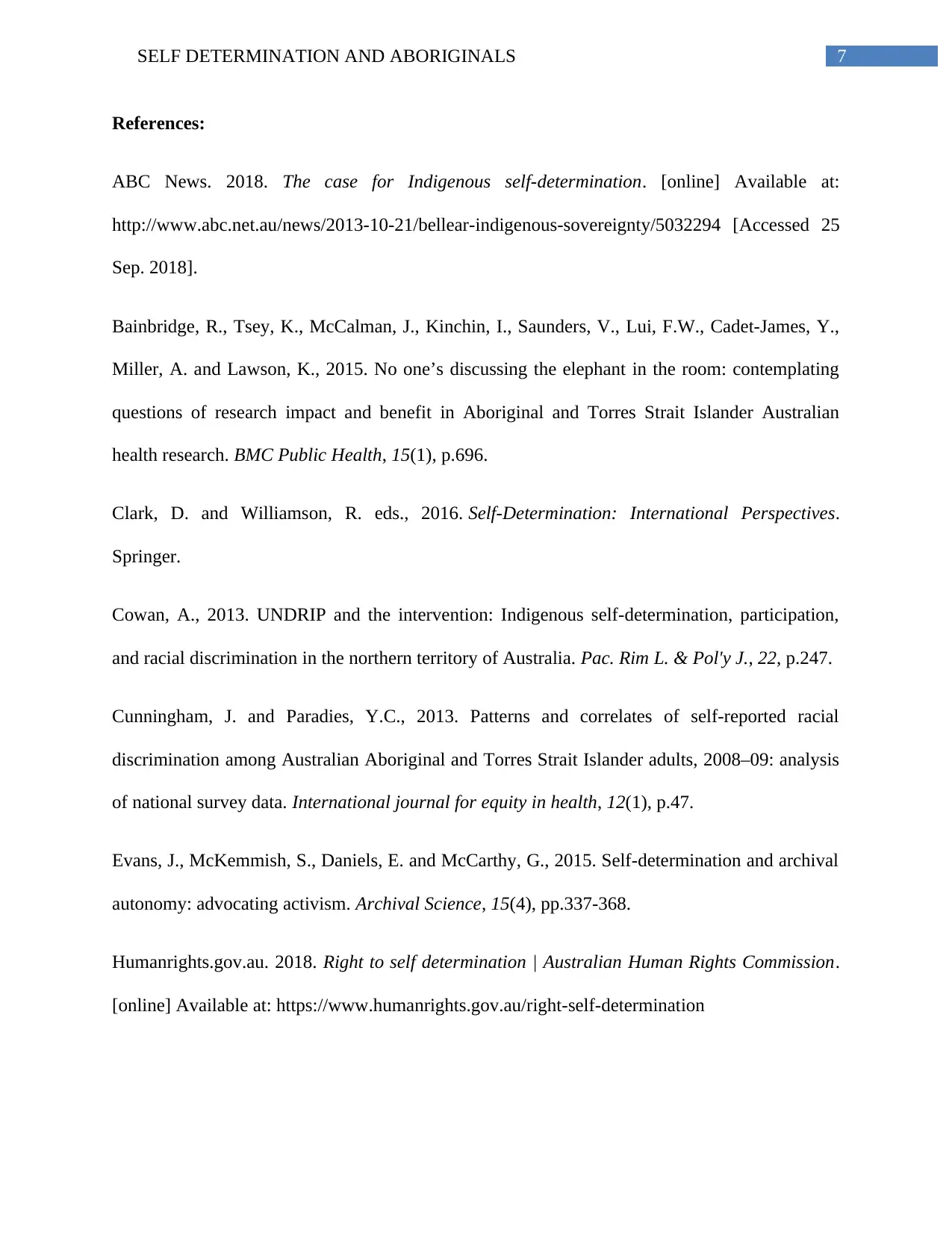
7SELF DETERMINATION AND ABORIGINALS
References:
ABC News. 2018. The case for Indigenous self-determination. [online] Available at:
http://www.abc.net.au/news/2013-10-21/bellear-indigenous-sovereignty/5032294 [Accessed 25
Sep. 2018].
Bainbridge, R., Tsey, K., McCalman, J., Kinchin, I., Saunders, V., Lui, F.W., Cadet-James, Y.,
Miller, A. and Lawson, K., 2015. No one’s discussing the elephant in the room: contemplating
questions of research impact and benefit in Aboriginal and Torres Strait Islander Australian
health research. BMC Public Health, 15(1), p.696.
Clark, D. and Williamson, R. eds., 2016. Self-Determination: International Perspectives.
Springer.
Cowan, A., 2013. UNDRIP and the intervention: Indigenous self-determination, participation,
and racial discrimination in the northern territory of Australia. Pac. Rim L. & Pol'y J., 22, p.247.
Cunningham, J. and Paradies, Y.C., 2013. Patterns and correlates of self-reported racial
discrimination among Australian Aboriginal and Torres Strait Islander adults, 2008–09: analysis
of national survey data. International journal for equity in health, 12(1), p.47.
Evans, J., McKemmish, S., Daniels, E. and McCarthy, G., 2015. Self-determination and archival
autonomy: advocating activism. Archival Science, 15(4), pp.337-368.
Humanrights.gov.au. 2018. Right to self determination | Australian Human Rights Commission.
[online] Available at: https://www.humanrights.gov.au/right-self-determination
References:
ABC News. 2018. The case for Indigenous self-determination. [online] Available at:
http://www.abc.net.au/news/2013-10-21/bellear-indigenous-sovereignty/5032294 [Accessed 25
Sep. 2018].
Bainbridge, R., Tsey, K., McCalman, J., Kinchin, I., Saunders, V., Lui, F.W., Cadet-James, Y.,
Miller, A. and Lawson, K., 2015. No one’s discussing the elephant in the room: contemplating
questions of research impact and benefit in Aboriginal and Torres Strait Islander Australian
health research. BMC Public Health, 15(1), p.696.
Clark, D. and Williamson, R. eds., 2016. Self-Determination: International Perspectives.
Springer.
Cowan, A., 2013. UNDRIP and the intervention: Indigenous self-determination, participation,
and racial discrimination in the northern territory of Australia. Pac. Rim L. & Pol'y J., 22, p.247.
Cunningham, J. and Paradies, Y.C., 2013. Patterns and correlates of self-reported racial
discrimination among Australian Aboriginal and Torres Strait Islander adults, 2008–09: analysis
of national survey data. International journal for equity in health, 12(1), p.47.
Evans, J., McKemmish, S., Daniels, E. and McCarthy, G., 2015. Self-determination and archival
autonomy: advocating activism. Archival Science, 15(4), pp.337-368.
Humanrights.gov.au. 2018. Right to self determination | Australian Human Rights Commission.
[online] Available at: https://www.humanrights.gov.au/right-self-determination
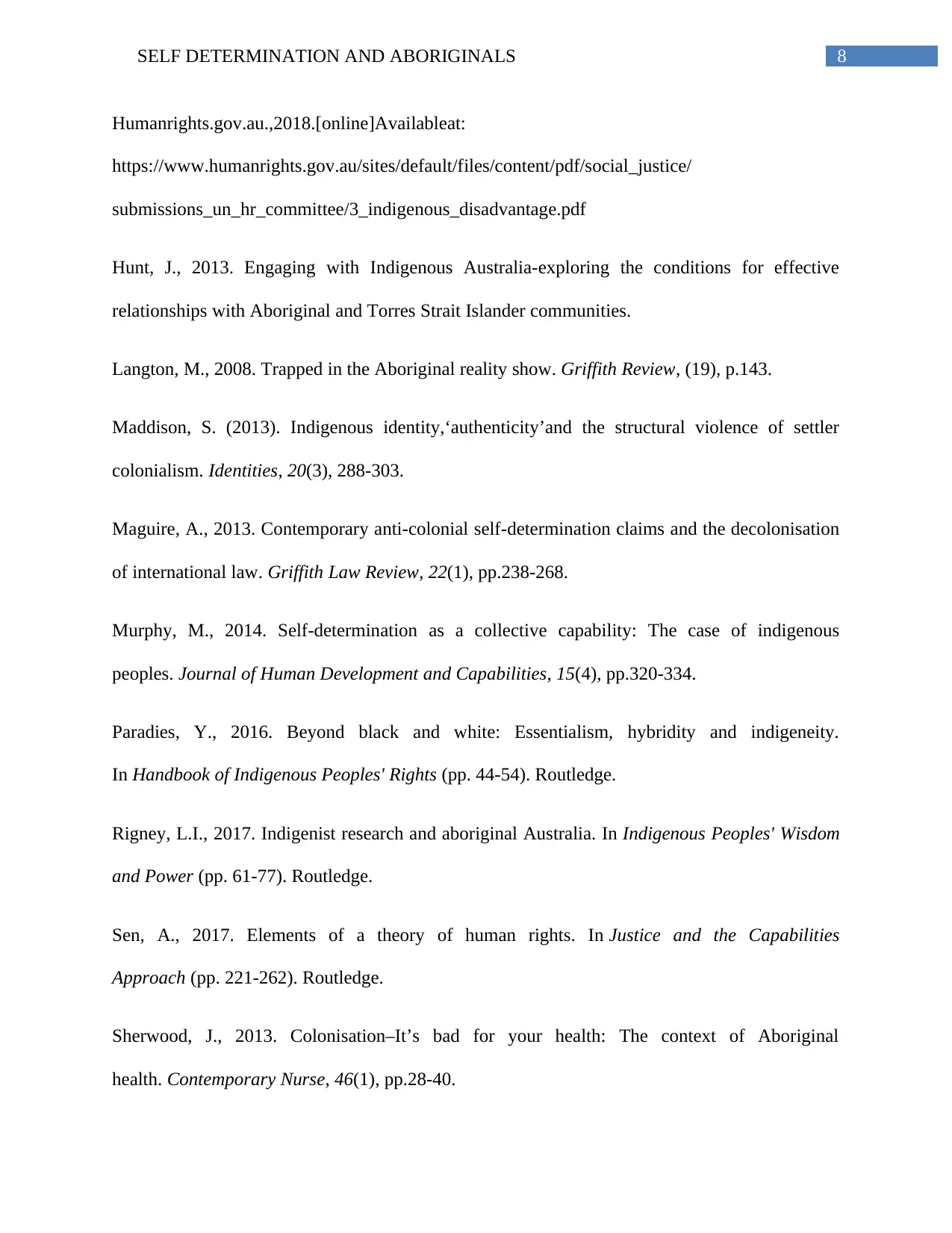
8SELF DETERMINATION AND ABORIGINALS
Humanrights.gov.au.,2018.[online]Availableat:
https://www.humanrights.gov.au/sites/default/files/content/pdf/social_justice/
submissions_un_hr_committee/3_indigenous_disadvantage.pdf
Hunt, J., 2013. Engaging with Indigenous Australia-exploring the conditions for effective
relationships with Aboriginal and Torres Strait Islander communities.
Langton, M., 2008. Trapped in the Aboriginal reality show. Griffith Review, (19), p.143.
Maddison, S. (2013). Indigenous identity,‘authenticity’and the structural violence of settler
colonialism. Identities, 20(3), 288-303.
Maguire, A., 2013. Contemporary anti-colonial self-determination claims and the decolonisation
of international law. Griffith Law Review, 22(1), pp.238-268.
Murphy, M., 2014. Self-determination as a collective capability: The case of indigenous
peoples. Journal of Human Development and Capabilities, 15(4), pp.320-334.
Paradies, Y., 2016. Beyond black and white: Essentialism, hybridity and indigeneity.
In Handbook of Indigenous Peoples' Rights (pp. 44-54). Routledge.
Rigney, L.I., 2017. Indigenist research and aboriginal Australia. In Indigenous Peoples' Wisdom
and Power (pp. 61-77). Routledge.
Sen, A., 2017. Elements of a theory of human rights. In Justice and the Capabilities
Approach (pp. 221-262). Routledge.
Sherwood, J., 2013. Colonisation–It’s bad for your health: The context of Aboriginal
health. Contemporary Nurse, 46(1), pp.28-40.
Humanrights.gov.au.,2018.[online]Availableat:
https://www.humanrights.gov.au/sites/default/files/content/pdf/social_justice/
submissions_un_hr_committee/3_indigenous_disadvantage.pdf
Hunt, J., 2013. Engaging with Indigenous Australia-exploring the conditions for effective
relationships with Aboriginal and Torres Strait Islander communities.
Langton, M., 2008. Trapped in the Aboriginal reality show. Griffith Review, (19), p.143.
Maddison, S. (2013). Indigenous identity,‘authenticity’and the structural violence of settler
colonialism. Identities, 20(3), 288-303.
Maguire, A., 2013. Contemporary anti-colonial self-determination claims and the decolonisation
of international law. Griffith Law Review, 22(1), pp.238-268.
Murphy, M., 2014. Self-determination as a collective capability: The case of indigenous
peoples. Journal of Human Development and Capabilities, 15(4), pp.320-334.
Paradies, Y., 2016. Beyond black and white: Essentialism, hybridity and indigeneity.
In Handbook of Indigenous Peoples' Rights (pp. 44-54). Routledge.
Rigney, L.I., 2017. Indigenist research and aboriginal Australia. In Indigenous Peoples' Wisdom
and Power (pp. 61-77). Routledge.
Sen, A., 2017. Elements of a theory of human rights. In Justice and the Capabilities
Approach (pp. 221-262). Routledge.
Sherwood, J., 2013. Colonisation–It’s bad for your health: The context of Aboriginal
health. Contemporary Nurse, 46(1), pp.28-40.
⊘ This is a preview!⊘
Do you want full access?
Subscribe today to unlock all pages.

Trusted by 1+ million students worldwide
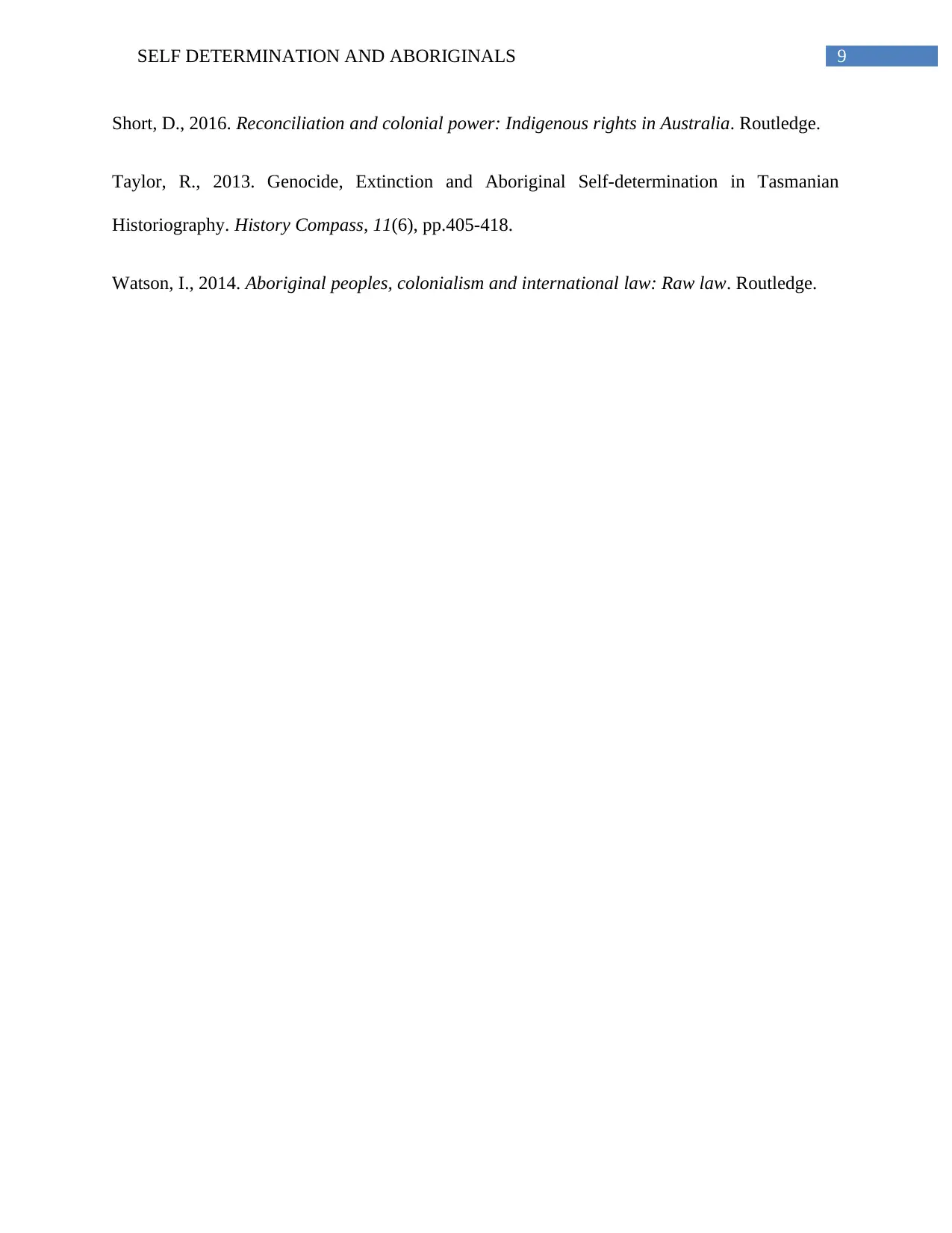
9SELF DETERMINATION AND ABORIGINALS
Short, D., 2016. Reconciliation and colonial power: Indigenous rights in Australia. Routledge.
Taylor, R., 2013. Genocide, Extinction and Aboriginal Self‐determination in Tasmanian
Historiography. History Compass, 11(6), pp.405-418.
Watson, I., 2014. Aboriginal peoples, colonialism and international law: Raw law. Routledge.
Short, D., 2016. Reconciliation and colonial power: Indigenous rights in Australia. Routledge.
Taylor, R., 2013. Genocide, Extinction and Aboriginal Self‐determination in Tasmanian
Historiography. History Compass, 11(6), pp.405-418.
Watson, I., 2014. Aboriginal peoples, colonialism and international law: Raw law. Routledge.
1 out of 10
Related Documents
Your All-in-One AI-Powered Toolkit for Academic Success.
+13062052269
info@desklib.com
Available 24*7 on WhatsApp / Email
![[object Object]](/_next/static/media/star-bottom.7253800d.svg)
Unlock your academic potential
Copyright © 2020–2025 A2Z Services. All Rights Reserved. Developed and managed by ZUCOL.





